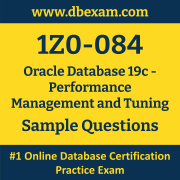 The Oracle Performance Management and Tuning (1Z0-084) Sample Question Set is designed to help you prepare for the Oracle Certified Professional, Oracle Database 19c - Performance Management and Tuning certification exam. To become familiar with the actual Oracle Certification exam environment, we suggest you try our Sample Oracle 1Z0-084 Certification Practice Exam.
The Oracle Performance Management and Tuning (1Z0-084) Sample Question Set is designed to help you prepare for the Oracle Certified Professional, Oracle Database 19c - Performance Management and Tuning certification exam. To become familiar with the actual Oracle Certification exam environment, we suggest you try our Sample Oracle 1Z0-084 Certification Practice Exam.
This Oracle Database 19c - Performance Management and Tuning certification sample practice test and sample question set are designed for evaluation purposes only. If you want to test your Oracle 1Z0-084 knowledge to identify your areas of improvement and get familiar with the actual exam format, we suggest you prepare with the Premium Oracle Certified Professional, Oracle Database 19c - Performance Management and Tuning Certification Practice Exam. Our team of Oracle Database experts has designed Questions-Answers for this premium practice exam by collecting inputs from recently certified candidates. Our premium Oracle 1Z0-084 certification practice exam will boost your confidence as well as your actual Oracle Performance Management and Tuning exam result.
Oracle 1Z0-084 Sample Questions:
Answers:
|
Question: 01 Answer: c |
Question: 02 Answer: d |
Question: 03 Answer: a |
Question: 04 Answer: b |
Question: 05 Answer: c |
|
Question: 06 Answer: a |
Question: 07 Answer: b |
Question: 08 Answer: d |
Question: 09 Answer: c |
Question: 10 Answer: d |
